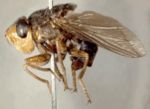Dermatobia hominis
Jump to navigation
Jump to search
| This article is still under construction. |
| Also known as: | Human bot fly
|
Scientific Classification
| Class | Insecta |
| Order | Diptera |
| Family | Oestridae |
Hosts
Humans, many birds and most domestic and wild animals.
Identification
The mature larvae may grow up to 25mm in length. D. hominis are similar to Calliphora in appearance. They have a blue-black abdomen, and have yellow-orange head and legs.
Larvae are distinctive as they taper towards the posterior end
Life cycle
- Eggs laid on blood sucking flies such as mosquitoes
- These hatch when the mosquito next lands on a warm blooded animal
- Larvae penetrate skin causing painful swellings
- Larvae emerge after 35-42 days and fall to ground to pupate
- 4 month life cycle
Pathogenesis
- In humans, the larvae are most often found in swellings on the head and limbs
- Larvae cause painful swellings and distress to cattle
- Larvae cause production losses
- Wounds caused by exiting larvae can increase the prevalence of attack by other myiasis flies

